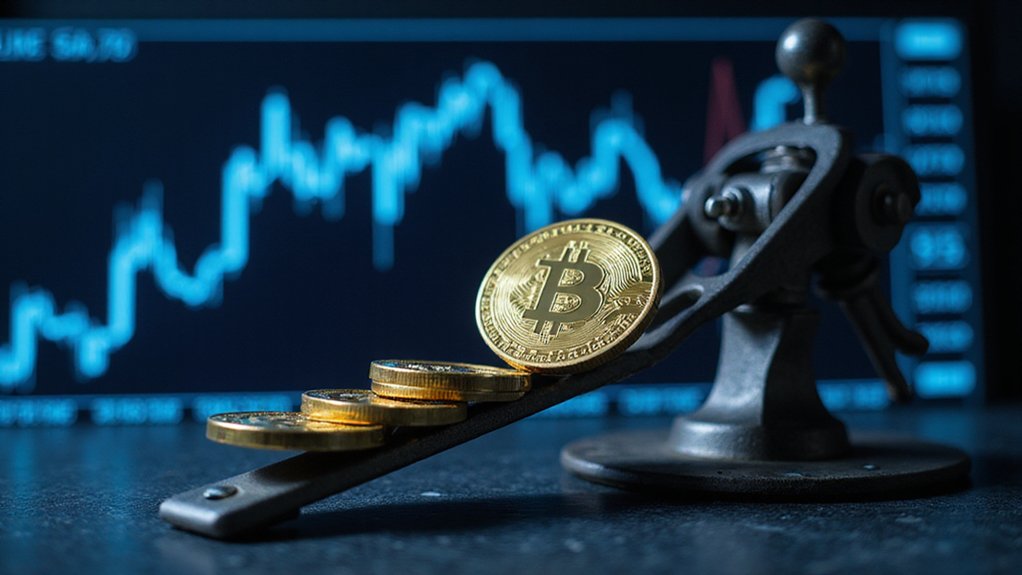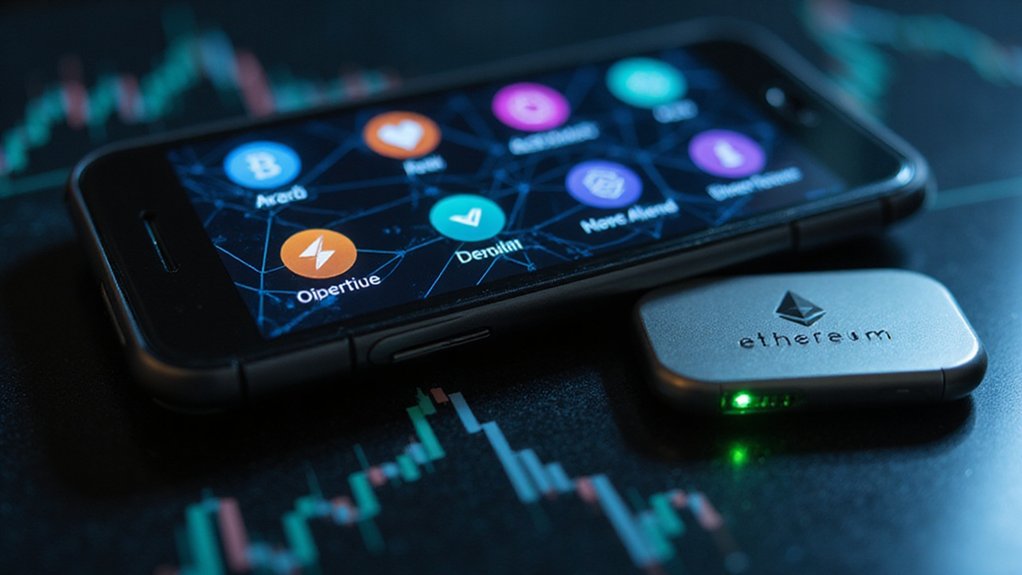Leverage in crypto trading functions as financial rocket fuel—magnifying potential returns by controlling larger positions with borrowed funds. A trader with $1,000 using 10x leverage effectively wields $10,000 in market power, transforming modest 2% price movements into 20% returns on capital. This double-edged sword cuts both ways, however, as losses accelerate at identical rates, potentially vaporizing entire positions. Prudent traders view leverage not as a wealth shortcut but as a precision tool requiring exceptional discipline. The deeper mechanics reveal both opportunity and peril.

While traditional financial markets have long employed leverage as a mechanism for amplifying returns, the crypto ecosystem has embraced this double-edged sword with characteristic fervor—often pushing the boundaries of what might be considered prudent risk exposure.
Leverage, at its core, allows traders to control positions substantially larger than their capital would otherwise permit, effectively borrowing funds to increase potential profits (and, inevitably, potential losses).
Leverage permits traders to punch above their financial weight class—amplifying both the sweet taste of victory and the bitter sting of defeat.
The practice has particularly flourished in crypto markets, where exchanges routinely offer leverage ratios that would make traditional brokers blanch—10x, 50x, even 100x in some jurisdictions where regulatory oversight remains conveniently distant.
The mechanics are straightforward enough: a trader deposits margin as collateral, which then serves as the foundation for a greatly amplified position. Traders can choose between isolated margin approaches that limit risk to the collateral allocated for a specific position, preventing losses from affecting the rest of the account.
A trader with $1,000 employing 10x leverage suddenly controls $10,000 worth of Bitcoin—a position that magnifies every market movement tenfold.
This capital efficiency permits nimble traders to capitalize on even modest price movements, with a mere 2% uptick translating to a 20% return on invested capital (before fees and funding costs, naturally).
The appeal is undeniable, particularly in a market where volatility creates frequent opportunities for short-term trades in both directions.
Leverage enables traders to short falling markets just as easily as they can ride bullish waves—a versatility particularly valuable in crypto’s characteristic boom-bust cycles.
Yet this power comes with commensurate risk.
The same 10x leverage that transforms a 5% gain into a 50% windfall will, with mathematical certainty, convert a 10% drawdown into complete liquidation.
Practitioners must contend with the constant specter of margin calls, where positions approaching liquidation thresholds require immediate capital injection or face forced closure—often at precisely the most disadvantageous moment.
Unlike buying spot assets, leveraged futures trading does not involve actual ownership of the underlying cryptocurrency, but rather represents an agreement to buy or sell at a predetermined price.
Platforms offer various instruments for leveraged exposure, from straightforward margin trading to futures contracts and options, each with distinct risk profiles.
Similar to Robinhood’s platform, many crypto exchanges display available buying power that accounts for your cash balance while excluding unsettled funds from previous transactions.
The prudent trader approaches leverage not as a shortcut to wealth, but as a precision instrument requiring exceptional discipline and risk management.
Frequently Asked Questions
How Does Leverage Amplify Both Gains and Losses in Trading?
Leverage functions as finance’s most elegant amplifier, magnifying both the triumphs and tragedies of market participation.
When traders control positions larger than their capital base (through basically borrowed funds), every price movement becomes proportionally exaggerated—a 1% asset appreciation translates to a 10% gain with 10:1 leverage.
This mathematical symmetry works with brutal efficiency in reverse; the same modest price decline transforms into a portfolio-decimating loss with identical magnitude.
The mechanism remains indifferent to human psychology, which rarely exhibits such balance.
What Are the Margin Call Requirements for Different Crypto Exchanges?
Crypto exchanges implement margin call requirements with notable variation.
Binance typically triggers liquidation at 120% maintenance margin, while Kraken sets it around 80% and Bybit around 100%.
FTX (pre-collapse) maintained a relatively aggressive 101.5% threshold.
These requirements—influenced by the exchange’s risk management philosophy, liquidity depth, and regulatory environment—essentially determine how quickly a position gets liquidated when markets move unfavorably.
Sophisticated traders often arbitrage these differences, capitalizing on the regulatory arbitrage inherent in the system.
Can Beginners Use Leverage Trading Strategies Effectively?
Beginners can technically deploy leverage, though the probability of success hovers somewhere between “finding a unicorn” and “winning the lottery.”
Most novices lack the technical analysis proficiency, risk management discipline, and emotional fortitude required for leveraged positions.
Starting with demo accounts, mastering range trading at 1:2 ratios, and establishing stringent stop-losses might give neophytes a fighting chance—but they’d be better served mastering spot trading fundamentals before amplifying both potential returns and catastrophic losses.
How Do Interest Rates Affect Costs in Long-Term Leveraged Positions?
Interest rates function as a gravitational force on long-term leveraged positions, with each percentage point increase amplifying carrying costs considerably over time.
Higher rates not only inflate direct borrowing expenses but also elevate opportunity costs (as capital could otherwise generate returns elsewhere).
During inflationary periods, central banks’ hawkish responses further compound these pressures—creating a double-edged sword where leveraged traders face both intensified funding costs and potentially dampened market sentiment.
The mathematics becomes rather unforgiving when compounded annually.
What Risk Management Tools Exist for Leveraged Crypto Trading?
Leveraged crypto traders employ several risk management tools to avoid the spectacular self-immolation that befalls the unprepared.
Stop-loss and take-profit orders provide automated exit mechanisms, while position sizing limits exposure relative to capital.
Diversification across assets with varying correlations smooths portfolio volatility, and trailing stops protect accumulated gains.
Quantitative tools—volatility analysis, standard deviation, and Sharpe ratios—help traders quantify risk exposure.
Of course, these safeguards only work when actually implemented—a detail many overlook until liquidation notices arrive.









